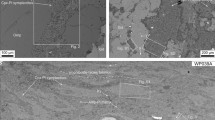Abstract.
There are many observations in naturally deformed rocks on the effects of mineral reactions on deformation, but few experimental data. In order to study the effects of chemical disequilibrium on deformation we have investigated the hydration reaction plagioclase + H2O→ more albitic plagioclase + zoisite + kyanite + quartz. We utilized fine-grained (2–6 µm) plagioclase aggregates of two compositions (An54 and An60), both dried and with 0.1–0.4 wt% H2O present, in shear deformation experiments at two sets of conditions: 900 °C, 1.0 GPa (in the plagioclase stability field) and 750 °C, 1.5 GPa (in the zoisite stability field). Dry samples and those deformed in the plagioclase stability field underwent homogeneous shearing by dislocation creep, but samples with 0.1 to 0.4 wt% water deformed in the zoisite stability field showed extreme strain localization into very narrow (~1–3 µm) shear bands after low shear strain. In these samples the microstructures of reaction products in the matrix differ from those in the shear bands. In the matrix, large (up to 400 µm) zoisite crystals grew in the direction of finite extension, and relict plagioclase grains are surrounded by rims of recrystallized grains that are more albitic. In the shear bands, the reaction products albitic plagioclase, zoisite, white mica, and traces of kyanite form polyphase aggregates of very fine-grained (<0.1 µm) dislocation-free grains. Most of the sample strain after γ ~2 has occurred within the shear bands, within which the dominant deformation mechanism is inferred to be diffusion-accommodated grain boundary sliding (DAGBS). The switch from dislocation creep in dry samples deformed without reaction to DAGBS in reacted samples is associated with a decrease in flow stress from ~800 to <200 MPa. These experiments demonstrate that heterogeneous nucleation driven in part by chemical disequilibrium can produce an extremely fine-grained polyphase assemblage, leading to a switch in deformation mechanism and significant weakening. Thus, localization of deformation in polyphase rocks may occur on any pressure (P),temperature (T)-path where the equilibrium composition of the constituent minerals changes.
Similar content being viewed by others
Author information
Authors and Affiliations
Additional information
Electronic Publication
Rights and permissions
About this article
Cite this article
Stünitz, H., Tullis, J. Weakening and strain localization produced by syn-deformational reaction of plagioclase. Int J Earth Sci 90, 136–148 (2001). https://doi.org/10.1007/s005310000148
Received:
Accepted:
Published:
Issue Date:
DOI: https://doi.org/10.1007/s005310000148




